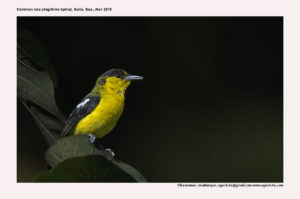
Common Iora Aegithina tiphia
Etymology:
- Aegithina : Greek word for aigithos or aiginthos unknown and mythical bird
- Tiphia : Greek word Tiphys, pilot of the Argonauts, his birthplace, Tipha in Boeotia
Vernacular Names: Hindi: Shaubeega, Desi/ Samanya Shaubeegi, Sans: Bharat shukkika, Pun: Latu, Ben: Fatik-jal, Ass: Krishna sorai, Barsat-sorai, Cachar: Daotisha gurrmo, Mikhir: Vohjong pong, Naga: Inga-ruina, Guj: Shobinga, Madhya bharati shobinga, Pilo shobigi, Mar: Cheroka, Subhag/Shubhalg(?), Ta: Pachapora, Chinna mambala-kuruvi, Mambala chittu, Te: Patsu-jitta, Pacha jitta, Pattra-jitta, Mal: Dadi-dee, Kan: Madhura kantha, Sinh: Kirikaye, Ca-kurulla, Panu-kurulla
Distribution in India: Widespread resident in India except in Northwest
Description: Size of 12·5–13·5 cm; wt. of male13–17 g, wt. of female 12–15 g. The male nominate race in breeding plumage has upperparts mostly green, crown is green with some black dusting, forehead, lores, face and underparts are yellow that is richest on throat and breast. The uppertail-coverts and tail is black; wings are black, median upperwing-coverts and tips of greater coverts are white forming two conspicuous bars. The sides of tertials and inner secondaries are white; iris is whitish; bill is light grey-blue with blackish culmen ridge; feet are slaty grey. The male in post-breeding eclipse plumage resembles female, but wings, uppertail-coverts and tail remain black. Female is duller, with black-dusted green uppertail-coverts and tail, underparts are green-washed and without rich golden tone on throat. The juvenile and subadult are like female. The races vary mainly in tone of greens, development of yellow collar, and extent of black on male upperparts: race septentrionalis (Foot of North West Himalayas in North India {Punjab, Himachal Pradesh}) is like nominate, but slightly larger, upperparts are slightly paler green, bill is longer and deeper; race humei (Central India) has black cap and mantle, variable black-fringed bright yellow hindcollar ,confluent with yellow of underparts, chalky-washed lime-green lower back and rump, eclipse plumage is female-like with upperparts as lime-green; race multicolor (extreme South India ) has no yellow hindcollar, black on body usually more extensive, rump is much darker, more grass-green, white bar on greater wing-coverts sometimes missing.
Habitat: It is found in mangroves, evergreen forest, pioneer coastal scrub and strand woodland, forest edge and light and broken woodland inland, and groves, bamboo thickets, orchards, plantations and scattered tall tree cover in agricultural and other disturbed sites. It is found from lowlands up to 1500 m.
Food habits: It eats insects and other arthropods and small fruits. It is a loner or in pairs and forages among twigs and foliage at crown level, preferring taller trees, moving often acrobatically to peer beneath leaves. It also darts out to snatch closely passing flying prey.
Breeding habits: They breed in Dec/Jan–Sept in Indian Subcontinent, but more tightly constrained to monsoon rain .The nest is built in branch fork or directly on bark surface of a bough, a thick-walled. The nest is a steep-sided open cup, built from tree cotton, fine grass, tendrils, fibre, etc., lined with fine fibre, comprehensively felted and anchored to support with cobweb. They lay a clutch of 2-4 eggs generally. The incubation starts from first egg, by both sexes. The incubation is done only by female at night, male taking slightly larger share of daytime duties. The incubation period is 14 days. Both parents tend nestlings and fledglings. They are important brood host of Banded Bay Cuckoo .